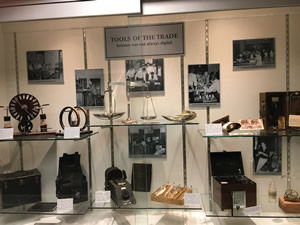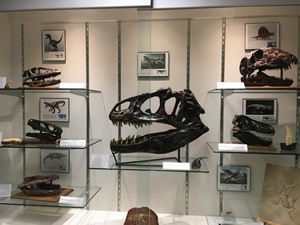Finding a Home for a Science Museum
- By Gary W. Breton, William T. Davin
- 11/01/17

PHOTO COURTESY OF BERRY COLLEGE PHOTOGRAPHY
Five scientists decide to build a museum…” This may sound like the beginning of a bad joke, but it was a reality for several scientists at Berry College in Mt. Berry, GA, who were given the task of designing, overseeing construction and curating a museum in the college’s science building, McAllister Hall.
The Brief Background Story
Our story began in 1997, when the science building was in its design phase. At the time, the school dean befriended former Berry students Irene and Dewey Large. The Larges believed that science museums were an excellent way by which to educate the general public about the wonders of science, a belief fueled by Dewey’s earlier work as curator for the National Museum of Atomic Energy in Oak Ridge, TN. The Larges provided start-up funds for the museum by way of donated property to be sold when it would be most profitable. In the meantime, the science building was designed and then constructed (in 2001) to include architectural features such as special alcoves that could easily be converted at a later date into spaces for museum displays. However, it wasn’t until 2014 that the property was liquidated and funds (about $40,000) became available to start our museum. As might be imagined, however, during those intervening 13 years the spaces that had been meant for the museum had been repurposed (mostly as study rooms), and no one had the appetite for their attempted repossession.
The Charge and Preparation

PHOTO COURTESY OF BERRY COLLEGE PHOTOGRAPHY
A museum committee was formed with diverse faculty and departmental representation from the departments of Chemistry, Biology, Physics, Mathematics and Animal Science. The committee was asked (rather broadly) to “use the available funds to create a museum in the science building.” Following many hours of discussions, the committee agreed that the museum should be 1) attractive to visitors of all age groups to the college and science building (including often-visiting elementary school groups); 2) educational in nature (and ideally of practical use to faculty members teaching some science courses); 3) reflective of the character of the college; 4) adaptable; and 5) mindful of the wishes of the extended Large family. Beyond that, not one of the committee members had any experience with museums... or any notion as to how to get started.
Fortunately, the Tellus Science Museum (a Smithsonian affiliate) is near the college, and some of us knew the executive director. We asked the director to visit with the committee and he gladly (thankfully!) accepted. He offered advice on everything from possible styles of display cases, what makes for an interesting display and how to collect items for display; to lighting issues and selecting appropriate fonts for labeling. He also surveyed the area we had tentatively singled out as the most appropriate place in the science building to house the museum, and gave us the thumbs up.

PHOTO COURTESY OF GARY W. BRETON
Locating that appropriate place wasn’t easy. With classroom space at a premium, and the previously designed “museum” spaces no longer available, the committee scoured the building for a suitable location. We were fortunate that there was a long, wide hallway available that was generally underutilized that was also not a critical access point. The hallway terminated at an exterior door; we reasoned that a museum space could be created if we simply rendered that door inoperable. While that made sense to us, it turned out we needed (per code) to maintain that door as an emergency exit to serve an adjoining auditorium. We were ultimately able to have the exterior handles removed, an “Emergency Exit Only” sign put in place and the windows covered to keep sunlight out of the area. On the whole, however, it seemed a convenient and logical spot for the museum with plenty of space (7 feet wide by 60 feet long by 10 feet high) for displays.
Our committee of scientists then launched two concurrent initiatives. First, design the museum so as to be compatible with the hallway. Second, decide what should be displayed in the museum (including what was already available).
Museum Design
The chosen hallway had some existing support columns on one side that broke up the space into natural “display” areas. However, we weren’t excited about simply sliding in prefabricated display cases since we wanted to avoid the museum looking like an amateurish collection of “stuff.” After hours of surfing the Internet for potential design ideas, we came across an image of a museum that looked attractive, professional and compatible with the hallway space.

PHOTO COURTESY OF GARY W. BRETON
It was also important that we attempt to transform the look of this space from a hallway to that of a museum. To this end we included in the plans an arched entrance, decorative columns, attractive raised lettering for the museum name and a distinctive color palette not found elsewhere in the building.
We called in representatives from the college’s Physical Plant to review the feasibility of the needed structural changes, and to also provide a cost estimate. This was important because we knew we would likely require funds to purchase some display items as well as display accessories (glass shelving, signage, display holders, accompanying photographs, etc.). The cost estimate of $25,000 (which included museum-quality glass display doors from an outside contractor) seemed reasonable, and allowed for some residual funds. Construction began during the summer of 2016 and was completed late in spring 2017.
Museum Curation
To begin to visualize what displays should look like and ways in which to complement the displays with accompanying photographs and explanatory signage, committee members took the time to visit the Tellus Science Museum as well as the college’s own Martha Berry Museum. Each departmental representative was responsible for searching through departmental holdings to find items that were amenable for display.

PHOTO COURTESY OF GARY W. BRETON
After collecting items from each of the departments, the director of the Tellus Science Museum was asked to return to Berry to review the items and provide advice on how they might best be displayed. At that meeting, the director also generously proposed that his museum would be willing to loan the college a display of high-definition paneled photographs of astronomical sights generated by the Hubble Space Telescope. In addition to the Hubble collection, the committee agreed to create displays of shells and sea creatures, antique scientific equipment, dinosaur skull replications and a history of the college as revealed by tree rings from a tree removed during construction of the science building.
Museum Grand Opening and the Future
In April, 2017, the family of Irene and Dewey Large gathered at a ribbon-cutting ceremony for the opening of the museum. The entire campus community was invited. After brief introductory remarks acknowledging contributions from the Large family and those involved in bringing the museum to life, the ribbon to the museum was cut and the community was invited to review the displays.
From the outset, the museum committee was adamant that establishment of the museum should not be the end of this project, but rather a beginning. Only by regularly updating the exhibits could we maintain ongoing viewer interest. In addition to new displays changes to the physical look are planned, such as adding track lighting and installing interactive displays. We also look forward to expanding the museum to other areas of the building as well.
This article originally appeared in the issue of .